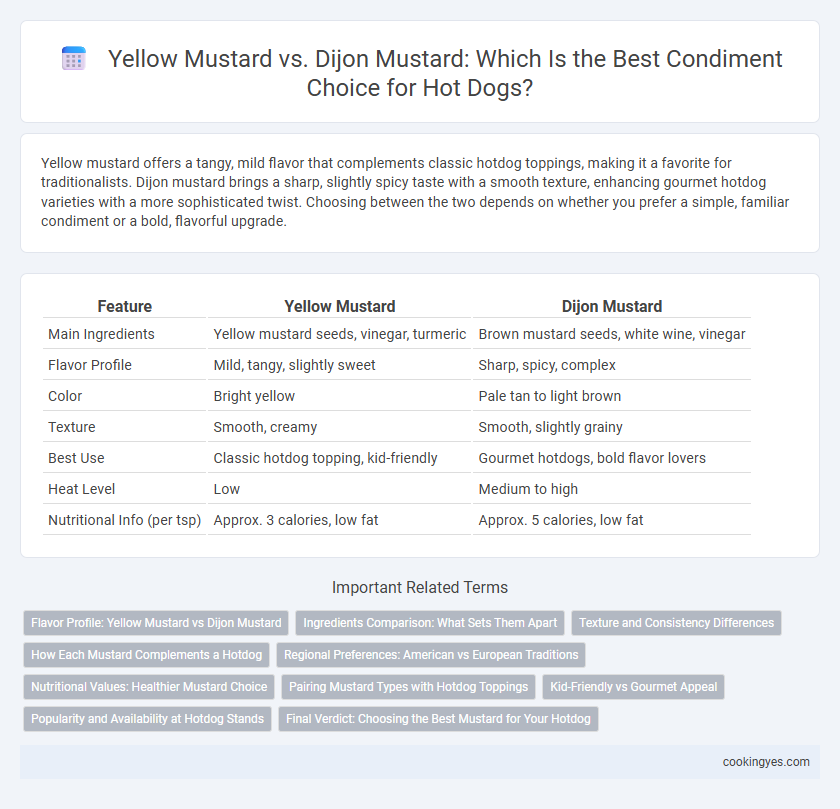Yellow mustard offers a tangy, mild flavor that complements classic hotdog toppings, making it a favorite for traditionalists. Dijon mustard brings a sharp, slightly spicy taste with a smooth texture, enhancing gourmet hotdog varieties with a more sophisticated twist. Choosing between the two depends on whether you prefer a simple, familiar condiment or a bold, flavorful upgrade.
Table of Comparison
| Feature | Yellow Mustard | Dijon Mustard |
|---|---|---|
| Main Ingredients | Yellow mustard seeds, vinegar, turmeric | Brown mustard seeds, white wine, vinegar |
| Flavor Profile | Mild, tangy, slightly sweet | Sharp, spicy, complex |
| Color | Bright yellow | Pale tan to light brown |
| Texture | Smooth, creamy | Smooth, slightly grainy |
| Best Use | Classic hotdog topping, kid-friendly | Gourmet hotdogs, bold flavor lovers |
| Heat Level | Low | Medium to high |
| Nutritional Info (per tsp) | Approx. 3 calories, low fat | Approx. 5 calories, low fat |
Flavor Profile: Yellow Mustard vs Dijon Mustard
Yellow mustard features a tangy, mildly spicy flavor with a bright, acidic bite that complements classic hotdog toppings without overpowering them. Dijon mustard offers a sharper, more complex taste profile with subtle hints of white wine and a smoother texture, enhancing gourmet hotdogs with its sophisticated zest. Choosing between yellow and Dijon mustard depends on whether a simple, traditional flavor or a bold, refined taste is desired for the condiment base.
Ingredients Comparison: What Sets Them Apart
Yellow mustard is typically made from milder yellow or white mustard seeds, vinegar, water, and turmeric, creating a bright yellow hue and tangy, straightforward flavor ideal for classic hotdogs. Dijon mustard, originating from France, uses brown or black mustard seeds blended with white wine or wine vinegar, resulting in a smoother texture and sharper, more complex taste. The difference in ingredients--turmeric and milder seeds in yellow mustard versus wine and stronger seeds in Dijon--defines their distinct flavor profiles and condiment roles.
Texture and Consistency Differences
Yellow mustard features a smooth, creamy texture with a consistent, thick spreadability ideal for classic hotdog applications, while Dijon mustard offers a finer, slightly grainy texture with a thinner consistency that provides a more elegant, less heavy coating. The creamy density of yellow mustard allows it to adhere well to the hotdog surface without running, contrasting with Dijon's lighter body, which can blend seamlessly with other toppings. Choosing between yellow and Dijon mustard hinges on the desired mouthfeel and overall condiment balance, making texture and consistency critical factors in hotdog preparation.
How Each Mustard Complements a Hotdog
Yellow mustard adds a tangy and slightly sweet flavor that enhances the classic hotdog taste, providing a bright contrast to savory toppings like ketchup and relish. Dijon mustard offers a sharper, more complex spice with hints of wine and mustard seeds, elevating gourmet or deli-style hotdogs with bold, refined flavor profiles. Choosing between yellow and Dijon mustard depends on whether you prefer a traditional, mellow condiment or a more sophisticated, pungent addition to your hotdog.
Regional Preferences: American vs European Traditions
Yellow mustard dominates as the classic condiment for hotdogs in American regional cuisine, prized for its mild tangy flavor and vibrant color that complements grilled sausages. In contrast, Dijon mustard holds a prominent place in European, particularly French, culinary traditions, offering a sharper, more complex taste profile with a hint of spice that elevates gourmet versions of the dish. These regional preferences reflect broader cultural palettes, with American hotdog culture favoring simplicity and color, while European traditions emphasize nuanced flavors and artisanal quality.
Nutritional Values: Healthier Mustard Choice
Yellow mustard contains fewer calories and less sodium compared to Dijon mustard, making it a healthier option for those monitoring their salt intake. Dijon mustard often includes white wine or vinegar, which can contribute to slightly higher sodium levels but also adds antioxidants. Both mustards are low in fat and sugar, but yellow mustard's simpler ingredient profile typically supports better heart health and weight management.
Pairing Mustard Types with Hotdog Toppings
Yellow mustard's tangy and mildly sweet flavor complements classic hotdog toppings like sauerkraut, onions, and relish, enhancing traditional American-style hotdogs. Dijon mustard offers a sharper, more complex taste that pairs well with gourmet toppings such as caramelized onions, sharp cheddar cheese, and spicy jalapenos, adding depth to artisanal hotdogs. Selecting between yellow and Dijon mustard depends on the desired flavor profile and the combination of toppings, balancing mild zest with bold intensity for an optimal hotdog experience.
Kid-Friendly vs Gourmet Appeal
Yellow mustard offers a mild, tangy flavor that is ideal for kid-friendly hotdogs due to its smooth texture and familiar taste, making it a popular choice among younger palates. Dijon mustard provides a sophisticated, slightly spicy kick with a creamy consistency, appealing to gourmet enthusiasts who seek a more refined condiment experience. Choosing between yellow and Dijon mustard balances simple enjoyment with elevated flavor complexity, catering to diverse preferences in hotdog toppings.
Popularity and Availability at Hotdog Stands
Yellow mustard remains the most popular choice at hotdog stands nationwide due to its classic tangy flavor and widespread availability. Dijon mustard, while appreciated for its gourmet and slightly spicy profile, appears less frequently and is often found at specialty or high-end vendors. Sales data indicates yellow mustard dominates condiment racks, accounting for over 70% of mustard sales at casual street food outlets.
Final Verdict: Choosing the Best Mustard for Your Hotdog
Yellow mustard offers a classic, tangy flavor with a smooth texture that complements the salty, savory taste of a traditional hotdog. Dijon mustard provides a sharper, more complex heat from mustard seeds and white wine, appealing to those seeking a gourmet upgrade. The best mustard choice depends on your preference for either the bold nostalgia of yellow mustard or the sophisticated zest of Dijon, ensuring your hotdog experience is perfectly tailored.
Yellow mustard vs Dijon mustard for condiment choice Infographic

 cookingyes.com
cookingyes.com